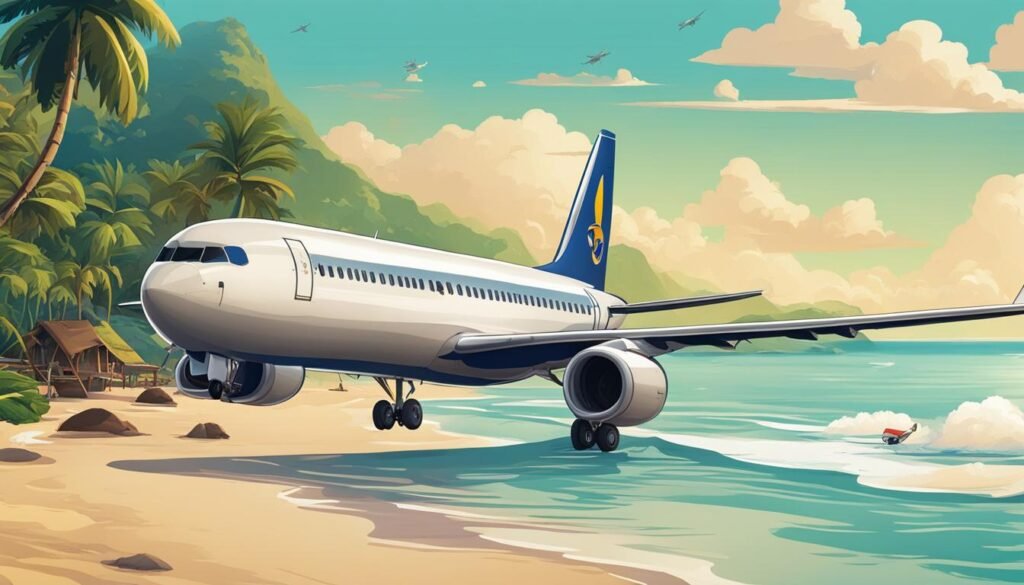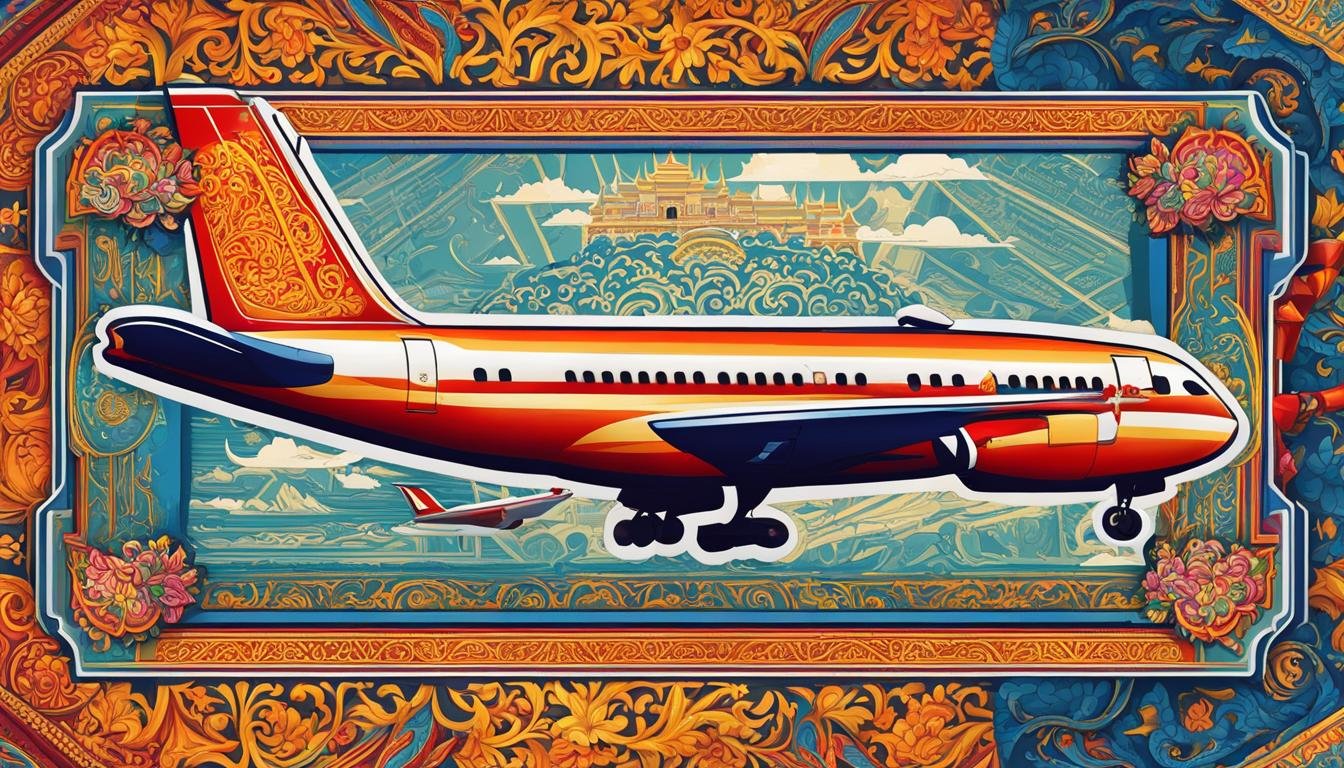Flights to Thailand have become increasingly expensive over the years due to a combination of factors. From the high demand for Thai destinations to fluctuating fuel costs, airport and overflight fees, and the competitive landscape of the airline industry, there are several reasons why flying to Thailand can be costly. It’s essential for travelers to understand these factors and plan ahead to find the best deals on flights to this beautiful Southeast Asian country.
Key Takeaways:
- Increased demand for Thai destinations contributes to higher flight prices, particularly during peak tourist seasons and for direct routes to less-touristed areas.
- Fluctuating fuel costs and airline operations, including geopolitical issues and fleet upgrades, can result in higher fares for passengers.
- Airport and overflight fees, driven by traffic increases and infrastructure improvements, directly impact the cost of flights to Thailand.
- The competitive landscape and airline alliances in the global aviation industry can lead to reduced competition on certain routes and higher ticket prices.
- Currency exchange rates, especially for the Thai baht, play a significant role in determining flight prices and the overall cost of traveling in Thailand.
Increased Demand for Thai Destinations
The popularity of Thailand as a tourist destination has skyrocketed in recent years, leading to a surge in the demand for flights to this tropical paradise. From the bustling streets of Bangkok to the stunning beaches of Phuket, travelers from all over the world are flocking to experience the rich culture, breathtaking landscapes, and warm hospitality that Thailand has to offer.
During the peak tourist season, which typically falls between November and March, the demand for flights to Thailand reaches its highest point. Tourists seek to escape the cold winter months in their home countries and embrace the tropical climate of Thailand. As a result, airlines often capitalize on this high demand by charging higher prices for flights during these popular travel times.
Moreover, the demand for direct routes to lesser-known destinations in Thailand has also contributed to the increase in flight prices. Travelers are increasingly seeking out unique experiences in off-the-beaten-path locations, which often require direct flights to reach. Airlines understand this trend and set higher introductory prices for flights to these destinations, taking advantage of the limited options available to travelers.
Direct Routes and High Introductory Prices
“Thailand is a hot spot for travelers seeking diverse experiences, and the demand for flights reflects that,” says travel expert Sarah Thompson. “During peak tourist season, it can be challenging to find affordable flights, especially if you’re aiming for direct routes or less-touristed areas. It’s always wise to plan ahead and be flexible with your travel dates to score better deals.”
Travel Tips: Navigating the High Demand
- Consider traveling during the shoulder seasons, such as April to June or September to October, when the demand for flights is lower, and prices are more affordable.
- Keep an eye out for airline promotions and discounts, which are often offered during non-peak travel periods.
- Be open to alternative routes or layovers, as they can sometimes lead to significant savings on flight tickets.
- Utilize fare comparison websites and sign up for fare alert notifications to stay informed about price drops.
- Consider departing from nearby airports or cities that offer more competitive fares.
By understanding the factors contributing to the increased demand for flights to Thailand and employing smart travel strategies, you can navigate the higher prices and find affordable options to embark on your dream Thai getaway.
Fuel Costs and Airline Operations
One of the key factors that contribute to the high cost of flights to Thailand is the fluctuating fuel costs. As fuel constitutes a substantial portion of airline operational expenses, any increase in oil prices directly impacts ticket prices. Geopolitical issues and environmental concerns can also lead to sporadic changes in fuel costs, further influencing the fares passengers pay to travel to Thailand.
Airlines also incur significant expenses from upgrading their fleets to meet safety and efficiency standards. These fleet upgrades, which include the purchase of new aircraft or retrofitting existing ones, require substantial investments. To cover these costs, airlines often raise their fares, resulting in higher ticket prices for passengers.
“Fuel costs are a major consideration for airlines, especially with the volatility of oil prices. Fluctuations in fuel costs can significantly impact their profitability. To offset these expenses, airlines may adjust their fares to maintain their financial stability.”
Therefore, the combination of fluctuating fuel costs and the need for airline fleet upgrades contributes to the higher fares for flights to Thailand.
Airport and Overflight Fees
Airport and overflight fees play a significant role in the high cost of flights to Thailand. As the country’s primary airports, such as Suvarnabhumi in Bangkok, experience increasing traffic, airport authorities have raised their fees to manage the influx of passengers and fund infrastructure improvements. These fees directly contribute to the higher prices of flights to Thailand.
Additionally, overflight fees, which are charges that airlines pay to fly over a country’s airspace, have also seen increases in certain regions. These fees are necessary for airlines to access and use the airspace of different countries, including Thailand. The costs associated with overflight fees are typically passed on to passengers, further contributing to the overall expense of flying to Thailand.
Airlines must factor in these airport and overflight fees when determining their ticket prices. This, combined with other factors like increased demand and fluctuating fuel costs, adds to the overall cost of flying to Thailand. To mitigate the impact of these fees, travelers can consider alternative airports and routes that may have lower fees or explore different airlines that offer competitive prices for flights to Thailand.
Competitive Landscape and Airline Alliances
The global aviation industry is highly competitive, with airlines constantly striving to gain an edge over their competitors. One way they achieve this is through the formation of airline alliances and partnerships. These alliances allow airlines to consolidate their operations, share resources, and expand their reach, ultimately reducing competition on certain routes. However, this consolidation can have an unintended consequence: higher ticket prices.
When airlines form alliances, they often align their pricing strategies, coordinate flight schedules, and collaborate on marketing efforts. This coordination allows them to optimize their operations and offer travelers a seamless travel experience. However, the reduced competition resulting from these alliances can lead to less competitive pricing.
“The consolidation of operations within the airline industry has undoubtedly impacted ticket prices. As airlines join forces, they can control pricing, limit seat availability, and minimize fare discounts, ultimately driving up the cost of air travel,” explains aviation analyst Jane Smith.
In the case of flights to Thailand, several major alliances dominate the market. This dominance can limit the options available to travelers and result in higher fares. With fewer airlines competing for passengers on these routes, there is less incentive to offer lower prices. Consequently, travelers seeking affordable flights to Thailand may face limited choices and higher ticket costs.

Planning Tips: Getting the Most Out of Your Money
- Monitor currency exchange rates and choose the right time to book your flights to Thailand.
- Consider using a credit card with favorable exchange rates or a travel card that doesn’t charge foreign transaction fees.
- Research and compare prices in different currencies to find the best deals.
- Be flexible with your travel dates to take advantage of any favorable changes in exchange rates.
- Consider exchanging some currency before your trip to avoid unfavorable rates at the airport.
“By keeping an eye on currency exchange rates and planning ahead, travelers can make the most of their budget and find affordable flights to Thailand.”
Conclusion
In conclusion, the high cost of flights to Thailand can be attributed to several factors. The increased demand for Thai destinations, especially during peak tourist seasons, leads to higher introductory prices and more expensive airfare. Fluctuating fuel costs, influenced by geopolitical issues and airline fleet upgrades, contribute to the overall expense of flying to Thailand. Additionally, airport and overflight fees have increased due to the growing traffic at Thailand’s primary airports, adding to the cost of flight tickets.
The competitive landscape of the airline industry also plays a role in the high ticket prices. Consolidation of operations and reduced competition on certain routes can result in higher fares for flights to Thailand. Moreover, currency exchange rates between the Thai baht and other global currencies affect the cost of flying to Thailand. When the Thai baht is strong, flight prices and the overall cost of traveling in Thailand become more expensive for international visitors.
Despite these challenges, there are strategies travelers can employ to find more affordable flight fares. Utilizing loyalty programs, monitoring fare comparison sites, considering nearby departure cities, and traveling during shoulder seasons can help secure better deals on flights to Thailand. By staying informed and planning ahead, travelers can navigate the factors impacting flight prices and make their journey to Thailand more budget-friendly.
FAQ
Why are flights to Thailand so expensive?
Flights to Thailand have become increasingly expensive over the years due to a combination of factors including increased demand for Thai destinations, fluctuating fuel costs, airport and overflight fees, the competitive landscape of the airline industry, currency exchange rates, and government taxes and tourism initiatives.
What contributes to the high cost of flying to Thailand?
Factors such as increased demand for Thai destinations, fluctuating fuel costs, airport and overflight fees, and the competitive landscape of the airline industry all contribute to the high cost of flying to Thailand. Additionally, currency exchange rates and government taxes and tourism initiatives can also impact flight prices.
How does increased demand for Thai destinations affect flight prices?
Thailand has become a top global tourist destination, leading to increased demand for flights. This demand is especially high during peak tourist months and for direct routes to less-touristed areas in Thailand. Airlines often charge higher prices to capitalize on this demand, making it more expensive to fly to Thailand during popular travel times.
What impact do fluctuating fuel costs have on flight prices to Thailand?
Fluctuating global oil prices significantly impact the cost of fuel for airlines. As fuel constitutes a substantial portion of their operational cost, any increase in oil prices is often reflected in ticket prices. Additionally, geopolitical issues and environmental concerns can lead to sporadic changes in fuel costs. Airlines also incur expenses from upgrading their fleets, which can result in higher fares for passengers.
Why do airport and overflight fees contribute to higher flight prices to Thailand?
Thailand’s primary airports, particularly Suvarnabhumi in Bangkok, have experienced significant increases in traffic. To manage this and fund infrastructure improvements, airport authorities have raised their fees. Overflight fees, which are charges airlines pay to fly over a country’s airspace, have also seen increases in certain regions. These airport and overflight fees directly contribute to the higher prices of flights to Thailand.
How does the competitive landscape and airline alliances affect flight prices to Thailand?
The global aviation industry operates on thin margins, prompting airlines to form alliances and partnerships to consolidate operations and reduce competition. However, this reduced competition on certain routes can lead to higher ticket prices. In the case of flights to Thailand, several major alliances dominate, potentially contributing to the higher fares.
How do currency exchange rates impact flight prices to Thailand?
The relationship between the Thai baht and other major global currencies plays a significant role in determining flight prices. When the Thai baht is strong compared to other currencies, flight tickets and other products priced in baht can become more expensive for international travelers. This dynamic affects not only flight prices but also the overall cost of traveling in Thailand for foreign visitors.

